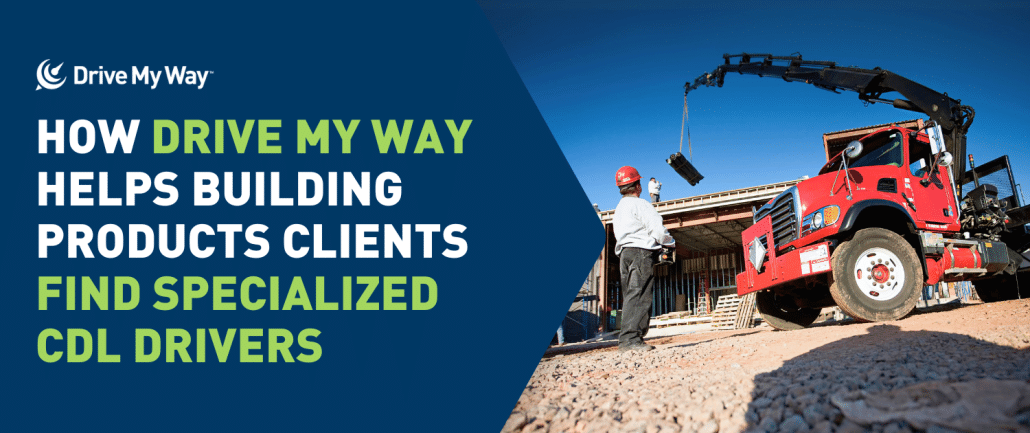
In the building products industry, the right drivers are more than just operators. They’re skilled professionals who combine safe driving with specialized equipment handling, customer service, and physical delivery work.
Finding these professionals, however, can be a challenge. Positions like CDL A and B straight-truck drivers, boom-truck operators, and yard spotters demand a unique mix of licensing, technical skills, and hands-on experience.
Drive My Way offers an option for companies navigating these hiring needs. With a trucking-exclusive platform and experience in sourcing niche CDL talent, we connect employers with drivers who meet precise role requirements and are ready to bring their expertise to the job.
A Trucking-Focused Solution for Niche Hiring
Unlike general job boards, Drive My Way is built specifically for recruiting truck drivers. The platform is designed to match employers with drivers who meet exact requirements, not just in licensing, but in equipment experience, delivery type, and work preferences.
For building products companies, this trucking-specific focus means they can quickly zero in on candidates who already understand their type of work. From CDL A/B straight-truck drivers with boom-operator certifications to local route specialists with customer-facing experience, Drive My Way helps employers connect with talent that fits.
“What’s been different with Drive My Way is we seem to get a much higher caliber of candidates in the pool,” said David Ullman, an HR Manager at J&L Building Materials. “Our driving positions are very niche. We’re looking for a very specialized candidate.”
Case Study: J&L Building Materials
Family-owned and operating since 1958, J&L Building Materials supplies professional contractors throughout Pennsylvania, Delaware, and New Jersey. They needed to recruit CDL A and B straight-truck drivers, including some with boom-truck operation skills, across multiple locations.
Before partnering with Drive My Way in October 2019, filling these positions was slow and inconsistent. However, with DMW’s platform, the process changed dramatically.
J&L’s David Ullman praised the clean, streamlined interface that made posting and managing jobs easy. “I’ve seen some other platforms out there that can be cumbersome. The Drive My Way solution is just a very clean, streamlined interface.”
Even more important, the candidates were exactly what they were looking for. Average time-to-hire dropped to under 30 days, even for highly specialized roles. The company also benefited from personalized support from their Customer Success Manager, who took time to understand their unique needs and offer targeted advice.
“I know we would not have had the success we have had without Drive My Way,” Ullman said. “Specifically, our Customer Success Manager took time to listen, ask questions, and then offered strategic guidance and insight that I wouldn’t have had.”
Case Study: Lansing Building Products
Lansing Building Products, a national exterior-products supplier with over 100 branches in 35 states, faced a similar challenge. They needed CDL A and B straight-truck drivers and yard spotters across a wide geographic range. The positions often required local deliveries, physical unloading, and customer interaction, making it critical to find candidates with the right qualifications.
When Lansing partnered with Drive My Way in early 2021, they were able to integrate the platform directly with their applicant tracking system, Lever. This seamless connection allowed them to move candidates through the hiring process more quickly, resulting in a consistent average of more than two hires per month.
“The great customer service is what I like best about Drive My Way,” said April Smith. “It’s what separates them from the other hiring resources we’ve used in the past.”
Drivers themselves also reported a positive experience with the application process. Marc, a CDL A driver in Rockaway, NJ, said, “It was the easiest experience I’ve had applying for a job. It was amazing.”
Russell, a CDL A driver in Greenville, SC, added, “It went great. I wasn’t familiar with Drive My Way before this, but I’m happy with the experience.”
By delivering both volume and quality candidates, DMW helped Lansing maintain a steady driver pipeline and meet its hiring goals in a competitive market.
Why Drive My Way Works for Building Products Companies
We’re proud of these success stories from J&L and Lansing, which highlight several key strengths that make Drive My Way a perfect fit for building products employers. These include:
- Specialized driver matching: Ability to filter and match for boom-truck certification, local delivery preference, and customer service skills.
- Clean, trucking-specific platform: Built for driver recruiting, without the clutter of unrelated job categories.
- Quality over quantity: Focus on delivering high-caliber candidates who match both qualifications and company culture.
- Personalized support: Customer Success Managers who understand the industry and provide strategic hiring insights.
- Technology integration: ATS compatibility to streamline the hiring process.
The Bottom Line
In the building products industry, success depends on having the right drivers behind the wheel who can safely operate specialized equipment, deliver materials efficiently, and represent the company well with customers.
These drivers may be hard to find, but Drive My Way’s trucking-exclusive platform and personalized approach make the search faster, easier, and more effective.
For more ways to stay ahead of the curve in the transportation industry in 2025, be sure to check out the rest of our Employer Blog posts and connect with us on social media.

 When a truck driver hands in their notice, many companies treat the departure as a done deal rather than a final opportunity.
When a truck driver hands in their notice, many companies treat the departure as a done deal rather than a final opportunity.  Private fleets are in a strong position when it comes to attracting experienced drivers. Typically, they can offer better compensation, more predictable schedules, and upgraded equipment.
Private fleets are in a strong position when it comes to attracting experienced drivers. Typically, they can offer better compensation, more predictable schedules, and upgraded equipment. 







